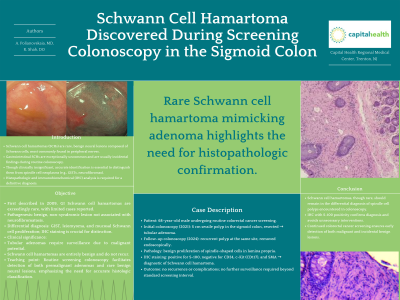Sunday Poster Session
Category: Colon
P0401 - Schwann Cell Hamartoma Discovered During Screening Colonoscopy in the Sigmoid Colon


Anastasiia Polianovskaia, MD
Capital Health Regional Medical Center
Trenton, NJ
Presenting Author(s)
1Capital Health Regional Medical Center, Trenton, NJ; 2Capital Health Gastroenterology, Trenton, NJ
Introduction:
Schwann cell hamartomas are rare, benign neural lesions primarily found in the peripheral nervous system but are exceptionally uncommon in the gastrointestinal (GI) tract. Their discovery during colonoscopy is often incidental, and they are of limited clinical significance due to their benign nature. However, distinguishing these lesions from other neoplasms through
histopathological examination is critical to appropriate clinical management.
Case Description/Methods:
A 68-year-old male underwent a routine screening colonoscopy as part of colorectal cancer surveillance. During the procedure, a 5 cm sessile polyp was identified in the sigmoid colon and subsequently resected. Histopathological examination revealed the polyp to be a
tubular adenoma. A follow-up colonoscopy three years later identified another polyp at the same site, which was diagnosed as a Schwann cell hamartoma. Immunohistochemical staining confirmed the diagnosis, differentiating the lesion from other spindle cell neoplasms.
Discussion:
Schwann cell hamartomas in the GI tract are exceedingly rare, having been first characterized in 2009. Immunohistochemical staining is essential for confirming the diagnosis, as it distinguishes these lesions from other spindle cell neoplasms, such as gastrointestinal stromal tumors (GISTs) and neurofibromas. While tubular adenomas are considered pre-malignant, Schwann cell hamartomas are entirely benign and require no further surveillance once excised. This case highlights the importance of routine colorectal cancer screening, as it facilitates the detection of both malignant and benign lesions. Schwann cell hamartomas, though rare, should be considered in the differential diagnosis of spindle cell lesions encountered during colonoscopy. Histopathological evaluation ensures accurate diagnosis and differentiates these benign lesions from more aggressive neoplasms. Regular colorectal screening remains essential in the early detection of pre-cancerous lesions like tubular adenomas and rare benign findings such as Schwann cell hamartomas.
Disclosures:
Anastasiia Polianovskaia, MD1, Ruchit Shah, DO2. P0401 - Schwann Cell Hamartoma Discovered During Screening Colonoscopy in the Sigmoid Colon, ACG 2025 Annual Scientific Meeting Abstracts. Phoenix, AZ: American College of Gastroenterology.
